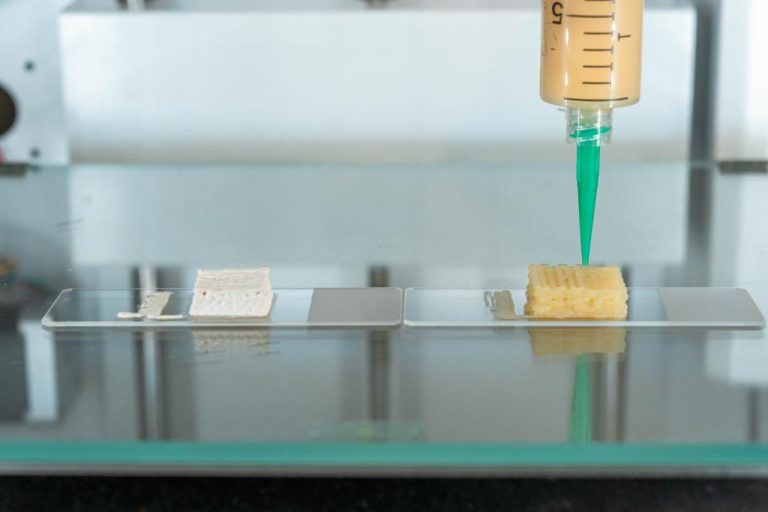TU Delft scientists are developing new living materials, which contain organisms such as fungi and algae, and could lead to adaptable and self-growing objects all around us.
Kunal Masania (sitting) with his PhD students Ingo Nettersheim and Mark Ablonczy in the biomaterials lab at Aerospace Engineering. (Photo: Thijs van Reeuwijk)
English only
Living materials could be described as the ‘new hot thing’ in material science. Unlike bio-inspired or bio-fabricated materials, they are literally alive and contain microorganisms that can potentially be ‘trained’ to react the way users need them to. For instance, materials containing tiny fungi could be self-growing and self-healing, while bioluminescent algae and certain bacteria could lead to fabrics that glow or change colour.
“While it is a relatively new line of research, there is a growing interest, and it is now moving at a fast pace,” says Elvin Karana, Professor of Materials Innovation and Design at the Faculty of Industrial Design Engineering. Her work covers a variety of living materials and organisms, including algae, bacteria, fungi, bacterial cellulose, and more. Even though “living materials are still in their infancy”, explains the expert, they hold enormous potential. Incorporating organisms directly into materials could lead to materials and products that are more resilient, adaptable and, above all, more sustainable.
Fungal network

Kunal Masania has printed octahedrons from various materials, fungal moulds included. (Photo: Thijs van Reeuwijk)
TU Delft scientist Kunal Masania, Associate Professor of Aerospace Structures and Materials, believes that living materials could be the future of aviation – and possibly even make life on Mars more feasible. His research, for which he received the ERC Consolidator Grant of EUR 2 million this year, focuses on developing living composites – using 3D printing, hydrogel and mycelium, a root-like structure of a fungus that normally lives underground.
“Fungi are resilient. They are very tolerant to harsh conditions, and they are relatively fast to grow. Most importantly, mycelium has the ability to grow a vast sensing network that allows it to send signals throughout the connected organism. This connectivity is the main feature we aim to exploit,” explains the Associate Professor.
Trick or retreat

Masania developed a 3D printing process with living materials (Photo: Thijs van Reeuwijk)
Masania has developed a new 3D printing ink based on hydrogel and inoculum, a small sample of the organism that can grow inside the hydrogel. The living organism in the material then forms connected structures that can electrically communicate with each other.
“When you shock the cells in mycelium, it triggers the release of calcium ions. These calcium ion signals go through the network to indicate that there is damage. This reaction triggers specific proteins that lead to the nucleus and let it know that it should respond,” he explains. “The nucleus can then respond in several ways – for example, it can thicken the walls to protect the organism, or it can retreat, and essentially die away in the damaged area. That is of course not what we want.”
What the scientist wants instead is to learn how to harness the electrical activity. At the moment, Masania’s team is busy measuring and interpreting the signals sent throughout the organism. By learning about the various signals, he aims to learn how the organism is feeling – and therefore be able to ‘trick it’ into behaving the way we want it to. If we can harness these natural properties of mycelium, we could create materials that are more resilient, lighter and adaptable – as they can ‘heal themselves’ in case of damage, for example.
Flying sustainably

Living materials can be tough, resilient and suitable for harsh conditions. (Photo: Thijs van Reeuwijk)
While Masania focuses on the underlying science, the ultimate goal is to one day use his living composites in aviation and transport. “The materials we currently use in aviation are very lightweight and stiff, but also very brittle. They can break unexpectedly, and so we add a lot of safety layers. Because of this, we use them at a fraction of their full potential. Having materials that can adapt would mean we can really use them to the maximum,” clarifies the scientist.
“There are also people who are very interested in using such living composites on Mars, for example,” he adds. “You could potentially only take a few cells with you and utilise resources that are already there – you could bind them together with the fungi. The materials would also be good for habitats on Mars, because they have very good UV absorption. They can protect the environment you want to enclose very well. Moreover, it is a very tough and resilient material that can handle the harsh conditions.”
Professor Karana agrees that this is a very exciting line of research. “Kunal has chosen mycelium for its unique ability to grow, evolve, and regenerate over time. He is exploring the self-healing potential of these materials. While there are numerous technological challenges that Kunal needs to address, once overcome, the prospects are quite promising.”
Do you have a question or comment about this article?
michaela.nesvarova@gmail.com


Comments are closed.